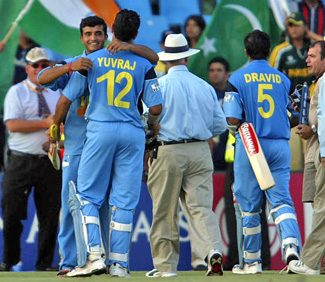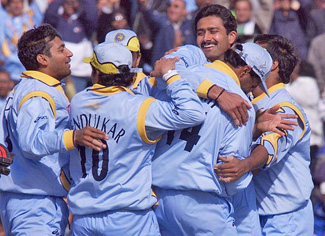ARTICLES
My best Test Series - Australia in India - 1969-70
- By S.P Bhatia
The score that the team batting second is chasing governs the strategy it adopts more than its comfort-zone.
Targets can be divided into three broad types:
1. Small
2. Huge
3. In-between
Small totals are generally achieved with minimum discomfort unless the wicket plays spoilsport. But then, batting-unfriendly wickets are a rarity in ODIs these days. A small total can become a winning one if the bowlers are disciplined and the chasing team becomes complacent. The Rothmans Cup game at Sharjah in 1985, wherein India bowled out Pakistan for 87 after being dismissed for 125 is remembered fondly even today.
If the target is huge, the chasers might well consider going for an out-and-out attack in the first 15 overs. Most teams believe in this approach. An alternate gameplan is to start steadily, get a feel of the wicket, the conditions and the bowling, and then move into top gear with plenty of wickets in hand. A 'bang bang' policy demands clarity on all counts. The openers need to be clear of what is expected from them. Are they both supposed to attack, or should one of them go for it and the other play second fiddle?
What approach a team will adopt in such a situation will depend upon its resources. A team like Pakistan, if confronted with a 300-plus target, will ask Shahid Afridi to go hammer-and-tongs. His partner, by no means as aggressive, will be told to hold one end up. On the other hand, if India or Australia are chasing, the openers (Sehwag-Tendulkar or Hayden-Gilchrist) will be told to go flat out. Like their Australian counterparts, Sehwag and Tendulkar are natural attackers. It will be utterly pointless to ask one of them to put down the shutters.
Quite a few teams prefer to set targets than chase them. This is because the pressure of overhauling a target can take its toll on the world's most experienced and intelligent batsmen. One can never predict when a wicket may fall and trigger a collapse.
The key to chasing a huge total is to plan the chase well, by defining the role of each player clearly and being ready with plans B and C if plan A fails. It is important to be composed and sensible. Recklessness should be avoided. It is not mandatory to hit fours and sixes to build the pressure on the bowlers, as aggressive running between the wickets can ensure a run-rate of six per over without any undue risks. The team that keeps wickets intact before entering the final stages ends up winning most of the time.
One of the best-planned chases was India's successful pursuit of Pakistan's 273 in the 2003 World Cup. Of course, Sachin Tendulkar's individual genius played a monumental part in the win. India got off to a flier, scoring nearly 120 in the first 15 overs for the loss of two wickets. The middle-order then played the consolidation job to perfection. What the openers had started, the middle-order finished in style with some practical, risk-free batting. They did not have to take chances, as the openers had scored at such a rapid pace that there were plenty of overs left. The middle-order was cool and collected, and yet did not refrain from punishing the lose deliveries. The final score read 276 for 4, India winning by six wickets.
The most dicey propositions are the 'in-between' targets. They leave the chasers uncertain; should we go on the offensive, or should we play out the full fifty overs instead? Many a time, a team that prefers the slow-and-steady approach and looks to bat out the innings can put itself into a position wherein the asking rate has climbed to 6-7 runs per over from the initial 4-5 runs per over. Another Indo-Pak World Cup encounter comes to mind. In the 1999 edition, India batted first and scored 227, a quintessential 'in-between' total. It wasn't an intimidating total, but neither was it one that the opposition could take lightly. The Pakistanis started well, playing their natural game, but became far too defensive as the innings progressed. They also kept losing wickets at regular intervals. The outcome - Pakistan was bowled out for 180 in the 46th over. With all due respect to the Indian bowlers, Pakistan lost the match because of the lack of strategy. They would have won had they played their natural game, which was a combination of attack with defence.
Hence, the best way for a team to tackle different targets is to bat according to its strengths.
Targets can be divided into three broad types:
1. Small
2. Huge
3. In-between
Small totals are generally achieved with minimum discomfort unless the wicket plays spoilsport. But then, batting-unfriendly wickets are a rarity in ODIs these days. A small total can become a winning one if the bowlers are disciplined and the chasing team becomes complacent. The Rothmans Cup game at Sharjah in 1985, wherein India bowled out Pakistan for 87 after being dismissed for 125 is remembered fondly even today.

The end of a well-planned chase - Indian skipper Sourav Ganguly hugs
Yuvraj Singh after India's victory over Pakistan in the 2003 World Cup.
Rahul Dravid is on the right.
What approach a team will adopt in such a situation will depend upon its resources. A team like Pakistan, if confronted with a 300-plus target, will ask Shahid Afridi to go hammer-and-tongs. His partner, by no means as aggressive, will be told to hold one end up. On the other hand, if India or Australia are chasing, the openers (Sehwag-Tendulkar or Hayden-Gilchrist) will be told to go flat out. Like their Australian counterparts, Sehwag and Tendulkar are natural attackers. It will be utterly pointless to ask one of them to put down the shutters.

A chase that went horribly wrong for the chasers - The Indians celebrate
the fall of yet another Pakistani wicket in the 1999 World Cup clash.
The key to chasing a huge total is to plan the chase well, by defining the role of each player clearly and being ready with plans B and C if plan A fails. It is important to be composed and sensible. Recklessness should be avoided. It is not mandatory to hit fours and sixes to build the pressure on the bowlers, as aggressive running between the wickets can ensure a run-rate of six per over without any undue risks. The team that keeps wickets intact before entering the final stages ends up winning most of the time.
One of the best-planned chases was India's successful pursuit of Pakistan's 273 in the 2003 World Cup. Of course, Sachin Tendulkar's individual genius played a monumental part in the win. India got off to a flier, scoring nearly 120 in the first 15 overs for the loss of two wickets. The middle-order then played the consolidation job to perfection. What the openers had started, the middle-order finished in style with some practical, risk-free batting. They did not have to take chances, as the openers had scored at such a rapid pace that there were plenty of overs left. The middle-order was cool and collected, and yet did not refrain from punishing the lose deliveries. The final score read 276 for 4, India winning by six wickets.
The most dicey propositions are the 'in-between' targets. They leave the chasers uncertain; should we go on the offensive, or should we play out the full fifty overs instead? Many a time, a team that prefers the slow-and-steady approach and looks to bat out the innings can put itself into a position wherein the asking rate has climbed to 6-7 runs per over from the initial 4-5 runs per over. Another Indo-Pak World Cup encounter comes to mind. In the 1999 edition, India batted first and scored 227, a quintessential 'in-between' total. It wasn't an intimidating total, but neither was it one that the opposition could take lightly. The Pakistanis started well, playing their natural game, but became far too defensive as the innings progressed. They also kept losing wickets at regular intervals. The outcome - Pakistan was bowled out for 180 in the 46th over. With all due respect to the Indian bowlers, Pakistan lost the match because of the lack of strategy. They would have won had they played their natural game, which was a combination of attack with defence.
Hence, the best way for a team to tackle different targets is to bat according to its strengths.